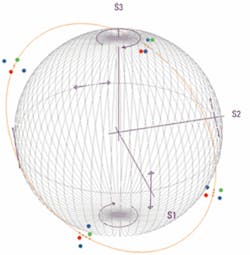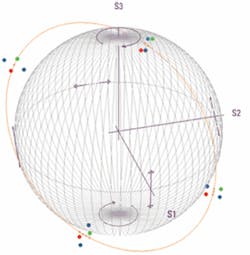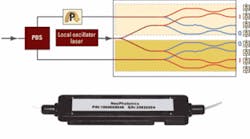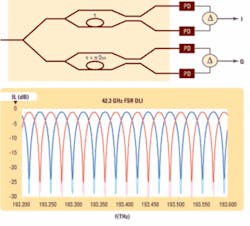Passive PICs are key elements in 40- and 100-Gbps systems
by Anthony Ticknor and G. Ferris Lipscomb
OVERVIEWThe transition to phase-modulated modulation formats for 40 and 100 Gbps puts new demands on passive component technology. Silica-on-silicon based planar photonic integrated circuits shows promise as a path toward meeting these challenges. Over the last decade, optical network capacity has been increased by using DWDM to create multiple simultaneous channels and by increasing the symbol rate within each stream. All the wavelength channels that can effectively get through the network with reasonable fidelity have been defined. With some debate, the practical limits of modulation rate for channels transported by those networks are being reached, and it is certainly not practical to replace the networks with some more exotic, denser transport medium every few years. We are now entering the era where the individual symbols will develop some character, each carrying more information than just the single binary bit of having power or not.A key stage of this progress is the impression of information onto the optical phase of the symbol. The detector must determine the optical phase of each symbol through comparison with a reference having a known phase relationship. The nature of this reference defines two branches of phase-modulated optical communications.
The first branch derives the reference from the signal stream itself at some earlier time (generally the previous symbol). Methods in this branch are generally recognized by a leading “d” for “differential” in their moniker, e.g., differential phase-shift keying (DPSK) or differential quaternary (or quadrature) phase-shift keying (DQPSK).
The second branch uses a local laser at the receiver, accurately tuned to the frequency of the source laser, as the reference. This branch is referred to as “coherent” due probably to its resemblance to early coherent-detection systems, and generally don't prefix the lone “d” (hence PSK, QPSK, etc.).
As is often the case, these terms have lost their value as technical distinctions; self-referenced systems are certainly coherent and the free-referenced systems may certainly employ differential encoding. Some transmission approaches employ only two phases and only carry one bit per symbol, hence provide the same bit rate as traditional transmission at the same frequencies. These have various fidelity and bandwidth advantages, but are not discussed here. By encoding the optical phase to one of four values, (D)QPSK modulation doubles the bit rate with little bandwidth penalty.
The reception task for multi-bit symbols is no longer simple power detection, but a more complex analysis of the arriving signal. The transmitted signal is received by an optical analysis system (complex interferometer) that uses the reference to demodulate the phase-encoded information into a set of detectable signals. These demodulators are precision assemblies of passive optical components and must be produced in fairly large numbers to support a cost-effective technology shift.As such, they are ideal candidates for photonic integration, and especially planar waveguide integration. Furthermore, since planar waveguides are manufactured by replication, it is very attractive to increase the complexity of the demodulator when it provides further improvement to the system performance. Taking advantage of this, many systems add an additional characteristic to the encoded symbol and again double the information to 4 bits per symbol. Due to this and other transmission advantages of phase-modulated signals, the coming generation of high-speed network links will carry 40 Gbps, and even 100 Gbps, in DWDM channels currently only supporting 10 Gbps.
In this paper we discuss the application and status of silica-on-silicon based planar demodulators for both coherent and differential applications, with particular focus on polarization effects and the hybrid integration of the active photodiodes directly onto the silicon substrate.
It is beyond the scope of this article to give an overall description of the many variations of these new optical signaling technologies, which have been covered in great detail in many sources.1,2,3 It will be instructive, however, to review the key features in general terms.
Presently, coherent systems are being investigated to employ four-phase encoding (QPSK). Due to the flexibility of the planar waveguide platform for demodulators, these systems are also encoding and recognizing four polarization states. Though confounding, this is referred to as “dual polarization,” or DP-QPSK. This is critically distinguished from polarization-maintaining (PM) approaches, where there are two independent polarizations kept distinct at each end of the transmission.
The DP approach encodes on the transmitted signal, in addition to one of four phases, one of four polarization states spaced evenly along a great circle on the Poincaré sphere. For instance, the four transmitted states may be linear horizontal, linear vertical, right-hand circular, and left-hand circular. During transmission, the polarization states may rotate, intermix, etc., and at the receiver end the signal emerges with four entirely different polarization states, but still evenly spaced along some other great circle along the Poincaré sphere. This is represented in Figure 1.Since the absolute phase difference between the local laser and the source laser is not determined, and the polarization transformation of the transport is not known, any symbol coming through the system must be analyzed relative to the preceding data. Once the link is calibrated, the drift of the reference phase and the polarization transformation are quite slow compared to the symbol rate. Since each symbol is analyzed, these drifts can be tracked and compensated during operation. The planar waveguide demodulator can be designed to provide for the analysis of both polarization and phase in a straightforward manner.
Each symbol ideally arrives in one of four polarizations, and within each polarization one of four phases, for a total of 16 possible states, providing 4 bits per symbol. In this way, a coherent link transmits 40 Gbps from a 10-Gbps modulation rate and 100 Gbps from a 25-Gbps rate, providing increased transmission capacity within existing DWDM transport systems.
A simple block diagram of a phase-encoded optical transmission system is shown in Figure 2. At the transmission end the signals are phase encoded onto the optical beam using electro-optic modulators based on lithium niobate or some other electro-optic material. The signal is then transported over the optical fiber link with its amplifier chain.
During this long-distance transmission the polarization of the optical signal is not controlled and the signal integrity is subject to all of the distorting effects, including chromatic and polarization-mode dispersion. Due to the deep analysis of each symbol described above, many of these distortions can be corrected by the detection process.
It is not within the scope of this paper to examine the phase encoding techniques, but they are well described in the previously mentioned references.
The phase demodulators used in coherent optical systems are passive systems that basically turn the phase- and polarization-encoded information into intensity information that can be detected in the normal manner by photodetectors. These demodulators are interferometers that are made up of couplers, splitters, and precisely defined optical paths and can be constructed using either free-space optics, as the early products were, or by integrated optics, as several vendors are currently doing.
Planar integrated optical implementations are made using optical waveguides defined on a planar substrate. Often this consists of glass waveguides on a silicon substrate and makes use of the same technology and manufacturing infrastructure that is used to manufacture arrayed waveguide gratings (AWGs) for wavelength multiplexing and demultiplexing in DWDM systems. Planar optical integration uses the manufacturing techniques of the semiconductor industry to manufacture highly complex precision structures in high volume and at low cost, and as such it is ideal for the manufacture of demodulators for coherent systems.
Figure 3 is a diagram of a dual in-phase quadrature (IQ) demodulator for a coherent DP-QPSK system. The polarization state of the incoming signal is unknown and changing, and so the signal is separated into two orthogonal polarizations and each one is analyzed separately. Both polarizations are interfered with a local oscillator laser, which is tuned to within a few megahertz of the frequency of the incoming signal and also serves as a polarization reference. The area inside the box consists of optical splitters, couplers, and delay lines and has been implemented in integrated optical form.
Within the integrated optics, polarizations are pure and wavelength response is flat; consequently, issues related to polarization frequency (wavelength) dependence are well managed. There are eight outputs, which go to eight different photodiodes if differential detection is used, or four outputs to four diodes if single-ended detection is used. Using digital signal processing (DSP), the transmission distortions can be electronically inverted and 4 bits can be extracted from the composite data. Also shown in Figure 3 is a photograph of a commercially available polarization in-phase quadrature (PIQ) demodulator.
A coherent system like the one shown in Figure 3 has the added expense of requiring a separate tunable laser at the receiver. To eliminate this extra element, many systems, particularly at 40 Gbps, use a time-delayed version of the received optical signal as the reference, in place of the local oscillator laser.
A schematic of a DQPSK demodulator is shown in Figure 4. The device consists of two delay-line interferometers (DLIs) through which the incoming optical signal is interfered with a version of itself delayed by the bit period t and by t+90°, giving the in-phase and quadrature signals. As in the case of the coherent mixer, the DQPSK demodulator consists of splitters and couplers and controlled optical paths and is ideal for optical integration.
DQPSK does not have an elementally flat wavelength response and places an additional requirement on the integration technology. Since the polarization of the incoming signal is unknown and uncontrolled and there is no local oscillator to provide a polarization reference, the DQPSK demodulator must be insensitive to polarization state to a very high degree.
In planar materials, there is usually some birefringence resulting in different behavior for each polarization, a phenomenon known as polarization-dependent frequency (PDF, also called polarization-dependent wavelength, or PDW). In a typical AWG application the principal effect of PDF is polarization-dependent loss (PDL), and PDF must be controlled to approximately 6 GHz to achieve the desired PDL of 0.5 dB. The requirements of DQPSK are much more stringent; PDF must be controlled to better than 400 MHz, or more than 10X better than in a typical AWG. Optical integration technology has improved markedly, and recent advances have achieved a PDF of 400 MHz, as is also shown in Figure 4.Differential systems that use two polarizations to carry information require that the polarizations be distinctly isolated before the DQPSK demodulator; as referenced previously, they are commonly referred to as polarization-maintaining or PM systems.
To avoid the complexity of coherent detection, most 40-Gbps implementations are approaching DQPSK. Similarly, since signal skew requirements are somewhat relaxed at 40 Gbps, most phase-modulated systems presentaly use separately packaged passive demodulators and detector subassemblies, connected by optical fiber. At 100 Gbps for coherent, and for better performance at 40-Gbps differential, it is anticipated that skew requirements and other performance needs will drive the integration of the demodulator and the detectors.
Presently, skew requirements for balanced detection are in the range of 1 psec, and certain to decrease in the future. This requires that the optical path length differences must be less than 200 µm. This is easy to achieve in an integrated optical chip, but is at the margin of what can be practically maintained for two separate packages connected by optical fibers having connectors or optical splices.
Due to the work that has been done to produce low-cost, high-volume biplexer and triplexer components for FTTH applications, hybrid integration technology has been developed that enables semiconductor devices, either photodiodes or lasers, to be mounted directly onto an integrated optical substrate. This technology is presently being adapted to the integration of photodiodes directly onto the coherent mixer and DQPSK demodulator substrates.
In conclusion, passive PICs based on silica waveguides on silicon substrates are ideal for manufacturing complex demodulators cost-effectively in high volume and with high performance. Passive PICs meet the stringent PDF requirements for DQPSK and are well suited to provide a platform for hybrid integration of the detectors for compact receivers with precisely controlled positioning and performance.
- Ip, Pak, Lau, Barros, and Kahn, “Coherent detection in optical fiber systems,” Optics Express, 16 (2008) p. 753.
- K. P. Ho, Phase-Modulated Optical Systems, Springer Science and Business Media.
- I. P. Kaminow, T. Li, and A. E. Wilner, editors, Optical Fiber Telecommunications V B, Academic Press/Elsevier.
Anthony Ticknor is director of R&D and G. Ferris Lipscomb is vice president of marketing at NeoPhotonics (www.neophotonics.com).
Lightwave: Photonic Integration Diverges down Two Paths
http://lw.pennnet.com/display_article/341917/13/ARTCL/none/none/1/Photonic-integration-diverges-down-two-paths/
Lightwave Online: Hybrid Optical Integration Project to Develop Modules for Optical Networks
http://lw.pennnet.com/display_article/330388/13/ARCHI/none/OCOMN/1/Hybrid-optical-integration-project-to-develop-modules-for-optical-networks/
Lightwave Online: Heavy Reading: Photonic Integration to Drive NG Optical Development
http://lw.pennnet.com/display_article/323548/13/ARCHI/none/NNEWS/1/Heavy-Reading:-Photonic-integration-to-drive-NG-optical-development/




